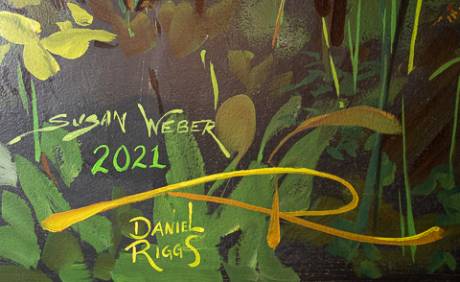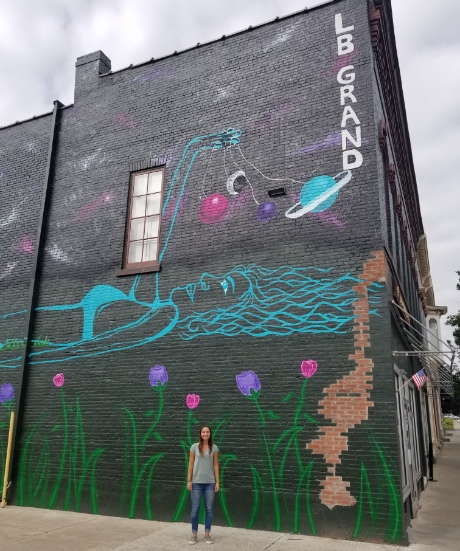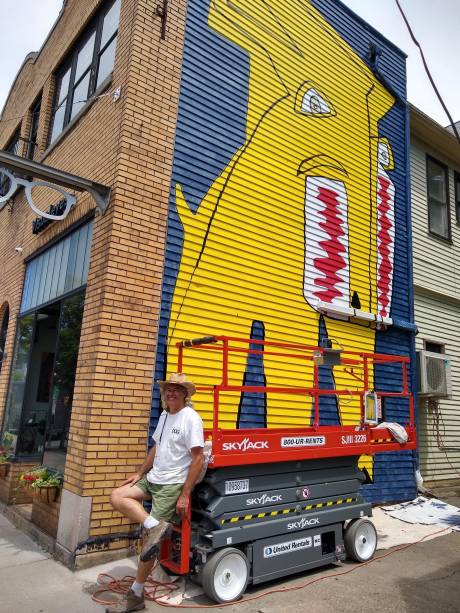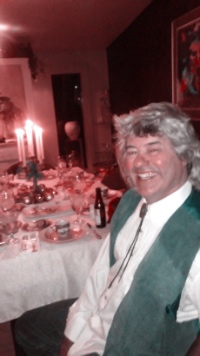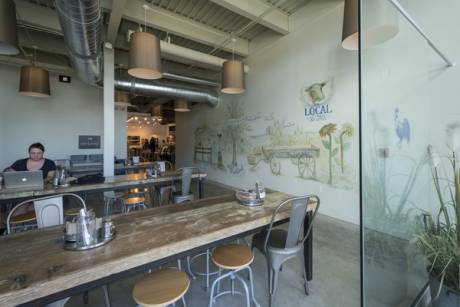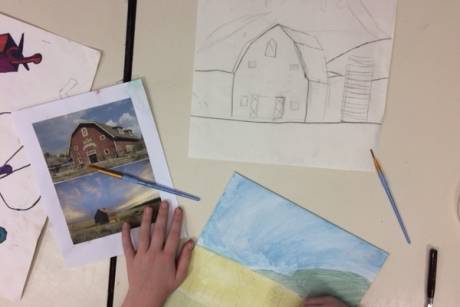Alabama Hotel's new mural

A new mural was commissioned for the dining room of the Alabama Hotel, located at routes 77 and 63 in Basom.
Owner Bonnie Woodward says, the mural in the main dining room was painted as a display of gratitude for all the hotel’s guests, and it encompasses many the highlights of the local area. The theme of the mural is “All Roads Lead to the Alabama Hotel.”
Bonnie explains the elements in the mural:
- The Alabama Hotel -- The painting of the hotel is a depiction of the structure dating back to the 1840s when it was first built. The entire section of the wall is a time capsule originating from the inception of the building, moving forward into the 1950s when the Woodward Family bought the Hotel, then forward to 2019 when Bonnie Woodward purchased it, and then finally to you -- the viewer at present.
- 1957 Buick Convertible – Bonnie wanted to embody the time period when the Hotel was acquired by the Woodward Family – 1956.
- Gas Pump – The building across from the Hotel, on the southwest corner, was at one point in time a gas station. The gas pump is from the 1950s and indicates the price of gas for that time period ($0.29/gallon).

- Iroquois National Wildlife Refuge – A very short drive west is this habitat which supports approximately 266 species of birds, 42 species of mammals, as well as fish, reptiles, amphibians and insects;
- Giant Wheel – Representing Six Flags Darien Lake in the Town of Darien. The real Giant Wheel propels riders 165 feet in the air.
- Darien Lake Amphitheater – Hosting performances from all your favorites with a capacity of 21,600 people.
- Steam Engine Tractor – The steam engine is a great way to represent the nearby Town of Alexander, which has hosted the Western New York Gas and Steam Engine Association and their respective annual rally since 1967.
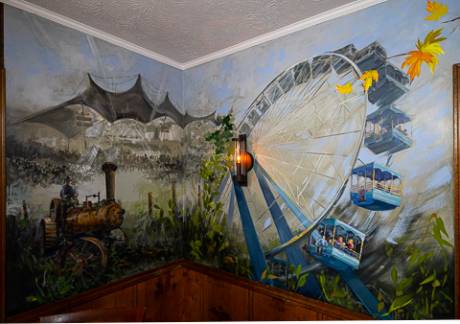
- Old Lockport Locks – Running 524 miles with 57 locks, 17 lift bridges, and 13 movable dams, the Erie Canal is yet another designated National Historic Landmark. The Canal was fully operational in 1825. There is an elevation change from Albany to Buffalo of 571 feet. Although the mural depicts the Lockport locks from their historical perspective, the locks have been reconstructed and now are the only double set on The Erie Canal. They raise boats 50 feet using three million gallons of water.
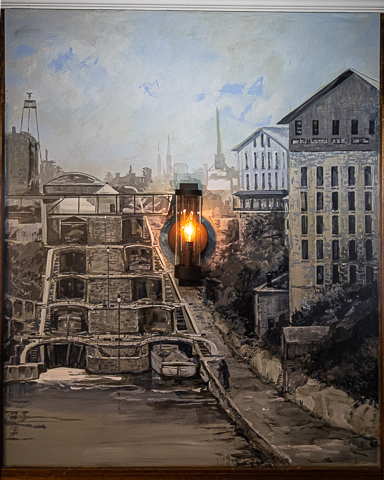
- Buffalo City Hall – Just a short distance from here is Buffalo – the second largest city in New York State. Buffalo City Hall is a historical Art Deco masterpiece that is at the center of what's happening in Buffalo today.
- McKinley Monument – The obelisk painted in front of City Hall is the McKinley Monument. This 96-foot tall structure defines the center of Buffalo where all the main roads converge. The monument was dedicated to the memory of President William McKinley who was fatally shot in Buffalo. On Sept. 14, 1901, following McKinley’s death, Vice President Theodore Roosevelt was inaugurated at the Ansley Wilcox House in Buffalo. He became the 26th President of the United States.
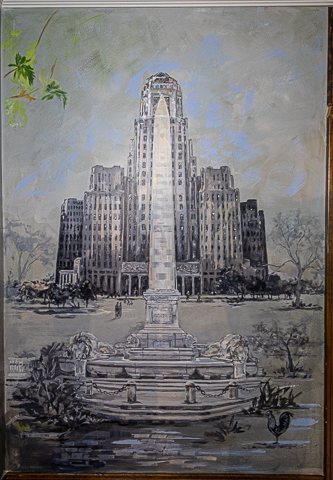
- Niagara Falls – Niagara Falls is considered the Eighth Wonder of the World. This major tourist destination is the result of Lake Erie dumping into Lake Ontario and it straddles part of the border between New York and Canada. You may find it interesting to know that the rate of water traversing the falls is controlled by employing a weir with movable gates upstream from the Horseshoe Falls. Peak tourist season as well as hydroelectric facilities are determinants of such control measures, as well as the extreme importance of erosion control. Niagara Falls, with its hydropower, is the largest electricity producer in New York State.
- Wine Barrel – Since 1850 more than 5,000 people have either intentionally or accidently gone over the falls. The first person, in 1901, to survive was 63-year old school teacher, Annie Edson Taylor. She successfully performed the stunt in an oak barrel. Of the thousands of subsequent attempts, only 16 others have reportedly survived. Stunting at Niagara Falls has been illegal since 1951 and surviving such a feat could still cost a daredevil up to $25,000 (USD) in fines.
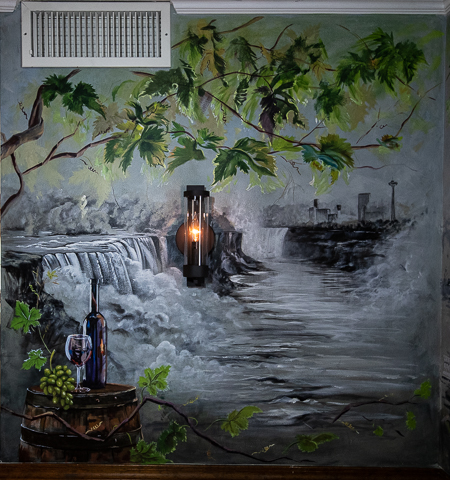
- Fresh Produce – Agriculture is a major component of the local economy. The Hotel is positioned in Genesee County, which is part of the Finger Lakes Agricultural Region -- the center of NY agriculture. This region hosts the largest amount of farmland in the State and ranks first in total amount of farm sales. The neighboring Western New York Region comprises of 5,100 farms and 870,000 acres of farmland (2012 U.S. Census Report).
- Maple Tree – The maple leaf is the chosen emblem of Canada. We are grateful to our friends to the north who have always contributed to the culture and tradition of the Alabama Hotel.
- Apples – At one point Western New York was the leading apple producing area in the country. Today, NY State farmers grow 40 varieties of apples – more than any other state. The state is currently the second-largest apple producing state in the nation (USDA).
- Onions – Neighboring Elba is known as the Onion Capital of the World in large part to the fertile mucklands. This title is upheld by the town’s annual Onion Festival and the crowning of its Onion Queen.
- Cary Seminary – Consistent with the theme of the other landmark structures, the artist captured the historic essence of the Cary Collegiate Seminary in neighboring Oakfield. The Seminary was opened in 1844 as a select boarding school and later became Oakfield High School. The building is now School House Manor – 27 apartments for the elderly.
- Milk Can – This is a symbolic homage to the local dairy industry; which is a major part of the economy. “The state has more than 4,000 dairy farms, is the fourth largest producer of milk [in the Nation], and is the largest producer of yogurt, cottage cheese and sour cream. The dairy community includes both large dairy operations and small, family-run farms. It also boasts processing of various types and sizes, from major global processing companies to small artisanal dairy product makers.”
- Holding Lantern – Homage to the Underground Railroad. The entire area of Western New York was filled with stops or stations with major stations in Buffalo and Rochester. At the stations, weary slaves were given food, rest and a change of clothing before continuing the last leg of the journey to freedom in Canada.
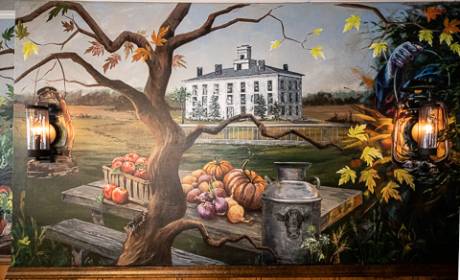
- Holland Land Office – Located in Batavia, the image is of the third and last office of The Holland Land Company. In 1960, the building was declared a National Historic Landmark, the first one in Western New York. If you’re keeping track, that is the third National Historic Landmark on the mural tour.
- Kodak Building – Nearby Rochester is known for the cultural icon of Eastman Kodak. With the slogan "you press the button, we do the rest" George Eastman put the first simple camera into the hands of a world of consumers in 1888. In so doing he made a cumbersome and complicated process easy to use and accessible to nearly everyone. Eastman’s Company has been at the center of most milestones in photography and digital imaging ever since.”
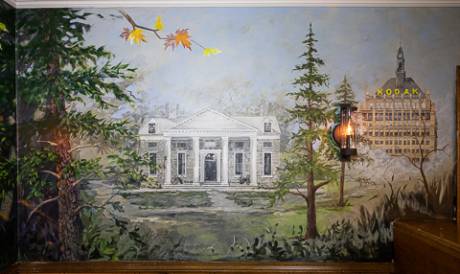
Signatures of artists Susan Weber from Alden and Daniel Riggs originally from Elba
